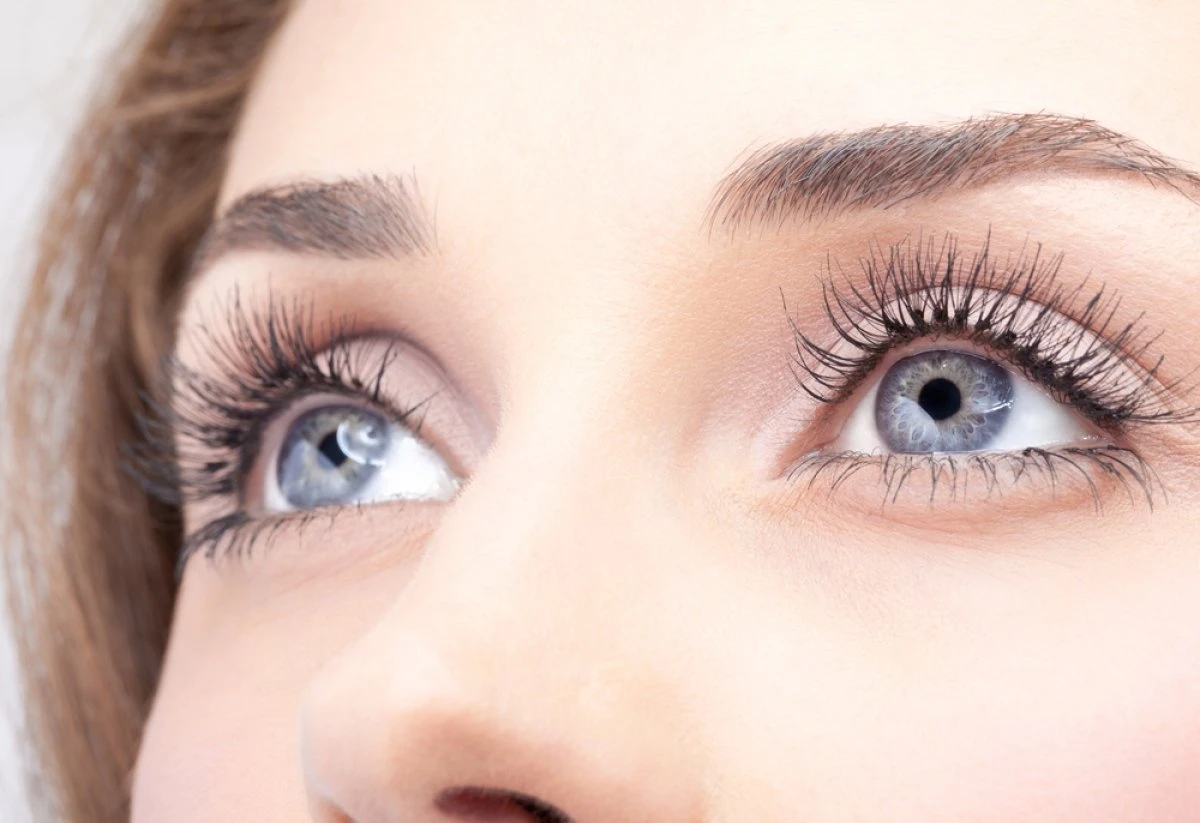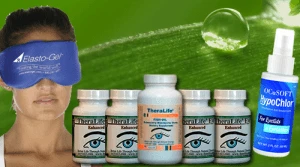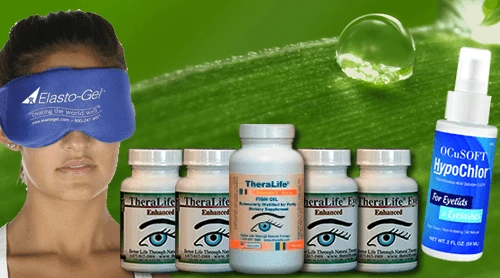To alleviate blepharitis symptoms, TheraLife’s products offer significant benefits to its customers. Their approach centers on using targeted natural supplements that enhance overall eye health, thereby addressing and managing blepharitis effectively. TheraLife’s products are designed to restore the meibomian gland function, improving tear film stability and reducing eye discomfort. These supplements also promote better blood circulation and eyelid hygiene, which are crucial for managing blepharitis. By using TheraLife’s products regularly, customers can achieve enhanced symptom control and explore additional strategies to manage eyelid inflammation effectively, supporting long-term eye health.
Best Blepharitis Treatment From TheraLife- When Drops Don’t Work.
Key Takeaways
- Warm compresses help liquefy and loosen meibomian gland secretions, making it easier to clean eyelid margins and remove crusts.
- Applying heat promotes circulation, reduces eyelid discomfort, and relieves sensations of irritation or itching associated with blepharitis.
- Regular warm compress use enhances gland function and helps stabilize the tear film, improving overall ocular comfort.
- Warm compress therapy supports eyelid hygiene routines by facilitating the removal of debris and promoting healing.
- Although not a cure, warm compresses are a simple, non-invasive way to manage symptoms and improve treatment outcomes for blepharitis.
Understanding Blepharitis and Its Causes
Blepharitis refers to the chronic inflammation of the eyelid margins, characterized by symptoms such as redness, irritation, and crusting. When you experience blepharitis, you’ll likely notice eyelid edema, foreign body sensation, photophobia, and sometimes excessive tearing.
The symptoms of blepharitis often worsen in the morning and can fluctuate based on underlying triggers.
The causes of blepharitis are multifactorial and commonly include bacterial colonization (such as Staphylococcus species), seborrheic dermatitis, and dysfunction of the meibomian glands.
Other contributing factors can involve allergic responses or parasitic infestations with Demodex mites. You might see a chronic or relapsing course due to the interplay of these factors.
Effective management relies on identifying the specific etiology because unaddressed sources can perpetuate both the symptoms of blepharitis and the risk of complicating ocular surface disorders.
In many cases, the use of warm compresses can provide significant relief by helping to unclog blocked meibomian glands, which is crucial for managing this condition.
Benefits of Applying Warm Compress to the Eyelids
When you apply a warm compress to your eyelids, you facilitate improved meibomian gland secretion, which helps stabilize the tear film. This therapy also decreases eyelid inflammation by promoting vasodilation and enhancing blood flow. As a result, you’ll notice reduced crusting along the lid margin and relief from ocular discomfort associated with blepharitis. Regular use of warm compresses can also enhance treatment outcomes by promoting healing and improving circulation around the eyelid area.
Improves Oil Gland Function
Although it’s often suggested that applying a warm compress can enhance meibomian (oil) gland function in blepharitis, current clinical evidence doesn’t support a significant improvement in gland activity or oil secretion from this practice.
When you use a warm compress, the intent is to liquefy thickened meibum and clear gland obstructions, theoretically enhancing gland health. However, studies show that while warmth may offer temporary symptomatic comfort, measurable benefits to oil gland output or composition remain unsubstantiated.
Despite widespread clinical recommendations, objective research indicates that warm compresses alone don’t increase baseline gland secretion or restore normal oil flow in cases of meibomian gland dysfunction. You shouldn’t rely solely on them for meaningful improvements in oil secretion or long-term gland health management in blepharitis.
Reduces Eyelid Inflammation
While you may assume that applying heat addresses inflammation triggers, clinical studies haven’t demonstrated any statistically significant reduction in conjunctival or eyelid edema or redness after warm compress use. Instead, warm compresses primarily target meibomian gland obstruction, a factor that causes blepharitis, by loosening inspissated gland secretions rather than directly reducing inflammatory processes. Despite the frequency of recommending warm compress therapy in clinical practice, you shouldn’t rely on this intervention for anti-inflammatory benefits. Medical guidelines emphasize that you still need additional treatments, such as topical corticosteroids or antibiotics, to address the underlying inflammation triggers and chronic immune response responsible for eyelid swelling and erythema in blepharitis. It’s also important to follow regular eyelid hygiene to help minimize symptom recurrence and maintain eye health.
Eases Crusting and Discomfort
While warm compresses don’t directly reduce eyelid inflammation, they do offer significant relief from the crusting and discomfort that frequently accompany blepharitis. When you apply a warm compress to your eyelids, the heat helps to liquefy and loosen meibomian gland secretions and accumulated debris. This softening effect facilitates crusting relief by making it easier to gently cleanse the eyelid margins and remove scaly buildup. The warmth also promotes increased vascular circulation, which can improve tissue flexibility and contribute to discomfort management. Patients often notice subjective improvement in irritation, itching, and foreign body sensation following consistent use. For effective blepharitis management, proper hygiene is crucial, and more aggressive hygiene solutions are necessary to achieve better outcomes.
Best Blepharitis Treatment From TheraLife- When Drops Don’t Work.
How Warm Compress Relieves Symptoms of Blepharitis
When you apply a warm compress to your eyelids, you facilitate the liquefaction of meibum within obstructed meibomian glands, promoting improved glandular secretion. This simple intervention reduces eyelid inflammation by diminishing pro-inflammatory cytokine activity and enhancing tear film stability. Clinical studies support that regular warm compress use leads to measurable symptom relief in patients with blepharitis. Additionally, artificial tears can further help in maintaining moisture and aid fluid drainage, providing comfort for those experiencing eye dryness.
Loosening Blocked Oil Glands
Even though warm compress therapy is commonly recommended for eyelid inflammation, evidence doesn’t support the claim that heat effectively loosens blocked oil glands in blepharitis.
Clinical studies have shown little correlation between warm compress application and the restoration of meibomian gland function. The common rationale is that heat should liquefy the thickened meibum in the meibomian glands, promoting oil gland hygiene and improving overall eyelid care.
However, recent evidence suggests the temperature and duration of at-home compresses rarely reach therapeutic thresholds required to unblock glands. Chronic eyelid disorders require comprehensive management strategies, and warm compresses alone generally don’t resolve meibomian obstruction or improve tear film stability in chronic blepharitis patients.
Instead, maintaining thorough daily eyelid care routines remains essential for managing gland dysfunction.
Professional interventions might be needed for persistent blockages, as warm compresses alone generally don’t resolve meibomian obstruction or improve tear film stability in chronic blepharitis patients.
Reducing Eyelid Inflammation
Although heat therapy remains a popular self-care measure for blepharitis, studies consistently indicate that warm compresses offer limited direct benefit in reducing eyelid inflammation. You might expect that increasing local blood flow and softening secretions would alleviate inflammatory symptoms, but clinical evidence suggests their anti-inflammatory efficacy is minimal. Instead, ophthalmologists recommend supplementing warm compresses with lifestyle changes and natural remedies for more substantial impact. Measures such as lid hygiene, omega-3 fatty acids, or topical anti-inflammatory medications should not be overlooked. Chronic blepharitis often requires a combination of treatments to manage symptoms effectively and prevent complications. The following table summarizes commonly used strategies:
| Intervention | Effect on Eyelid Inflammation |
|---|---|
| Warm compress | Limited, supportive |
| Lid hygiene | Moderate, essential |
| Omega-3 supplementation | Potential benefit |
| Topical antibiotics | Targeted, if infection present |
| Lifestyle changes | Supportive, long-term |
Carefully combining these methods often yields ideal outcomes.
Materials Needed for an Effective Warm Compress
Proper preparation guarantees that a warm compress delivers maximum therapeutic benefit in blepharitis management. For best outcomes, select compress materials that retain heat effectively and distribute warmth evenly over the eyelid margin. Commercially available microwavable eye masks, often filled with hydrophilic beads or flaxseed, offer superior thermal retention compared to traditional wet washcloths in effectiveness comparison studies. These specialty masks provide consistent temperatures for longer periods, thereby enhancing meibomian gland secretion liquefaction. Alternatively, a clean cotton washcloth soaked in warm water is acceptable, though it cools rapidly and requires frequent reheating. Always verify materials are free from contaminants to prevent secondary infection. Avoid synthetic fabrics or grain products that may harbor allergens or lose structural integrity after repeated heating cycles. Select safely designed compresses to maximize clinical efficacy. To further promote drainage and support optimal outcomes, incorporate warm compresses and lid massage techniques into your routine.
Step-by-Step Guide to Applying a Warm Compress
Effective application of a warm compress requires adherence to clinically validated steps that guarantee both safety and therapeutic benefit for blepharitis.
Begin by thoroughly washing your hands to prevent microbial contamination. Prepare your compress according to recommended application techniques—immerse a clean cloth in water heated to approximately 40°C (104°F), ensuring the temperature supports ideal heat retention but won’t cause thermal injury.
Gently wring out excess water to prevent dripping, then apply the compress directly over your closed eyelids, making full contact with the periorbital skin. Maintain light pressure to maximize thermal transfer without compromising comfort.
It is important to follow a consistent treatment regimen for effective management of blepharitis symptoms, as highlighted in recent clinical studies.
After several minutes, remove the compress and observe any ocular secretions released, which is a sign of effective meibomian gland expression. Repeat the procedure as clinically indicated.
Best Blepharitis Treatment From TheraLife- When Drops Don’t Work.
Frequency and Duration for Optimal Results
Most clinical guidelines recommend applying a warm compress to the eyelids two to four times daily, with each session lasting 5 to 10 minutes for ideal management of blepharitis.
Adhering to these frequency guidelines helps maintain efficacy, as regular heat application loosens meibomian gland secretions and improves tear film stability.
Duration recommendations emphasize that shorter sessions may not achieve therapeutic temperatures necessary for gland expression, whereas considerably longer exposure may cause skin irritation without added benefit.
You should allocate time for consistent sessions each day—morning and evening at minimum—to promote effective eyelid hygiene and inflammation control.
Regular implementation is shown to alleviate symptoms such as redness, irritation, and crusting.
Compliance with these evidence-based protocols optimizes clinical outcomes and supports long-term management of blepharitis.
Common Mistakes to Avoid During Application
Although warm compresses are generally safe and beneficial for blepharitis, several common mistakes can compromise their therapeutic effect and even exacerbate symptoms.
It’s essential to recognize both technique variations and common misconceptions to optimize your outcomes. Improper methods may reduce efficacy or contribute to ocular surface irritation.
Here are three mistakes you should avoid:
- Overheating the Compress: Using excessively hot water increases the risk of burns or additional inflammation. Always test compress temperature to maintain safety.
- Insufficient Duration: Removing the compress too soon fails to adequately liquefy meibomian gland secretions. Evidence suggests 8–10 minutes is ideal.
- Using Contaminated Materials: Reusing unwashed cloths promotes bacterial proliferation, undermining ocular hygiene and potentially worsening blepharitis.
Adhering to proper application protocols guarantees therapeutic benefits without negative sequelae.
Additional Tips for Managing Eyelid Inflammation
While warm compresses remain foundational in blepharitis therapy, thorough eyelid inflammation management involves additional strategies to optimize ocular surface health.
You should prioritize meticulous eyelid hygiene by cleansing the lid margins daily with a diluted, preservative-free cleansing solution or commercial eyelid wipes.
Implementing lifestyle changes such as minimizing screen time and avoiding eye rubbing can decrease exacerbating irritants.
Evidence suggests that dietary adjustments—specifically increasing omega-3 fatty acid intake from fish or flaxseed—support meibomian gland function and reduce inflammation.
Consider reducing processed foods and refined sugars, as these can promote systemic inflammatory responses.
Hydration also plays a role in maintaining tear film stability.
Finally, if you wear contact lenses, guarantee proper disinfection to mitigate bacterial biofilm formation, which could worsen eyelid symptoms.
When to Seek Medical Attention
Despite consistent self-care and lifestyle modifications for blepharitis, certain symptoms indicate the need for prompt medical evaluation.
Careful symptom monitoring is essential, as some signs suggest complications beyond routine management. If you develop any of the following concerning features, seek professional assessment promptly:
- Worsening eyelid swelling or redness: Progressing inflammation despite proper warm compress use may reflect secondary infection or cellulitis, requiring pharmacologic intervention.
- Visual disturbances: A sudden decrease in vision, double vision, or persistent blurred vision suggests possible corneal involvement or more serious ocular pathology that warrants immediate evaluation.
- Severe pain or purulent discharge: Intense discomfort or thick, yellow-green discharge from the eyelid or eye suggests an acute infectious process demanding urgent medical attention.
Don’t ignore persistent or escalating symptoms; timely medical evaluation guarantees ideal management and prevents vision-threatening complications.
Best Blepharitis Treatment From TheraLife- When Drops Don’t Work.
Frequently Asked Questions
Can Children Use Warm Compresses for Blepharitis?
If you’re concerned about children’s safety, you can use warm compresses for blepharitis, provided you supervise the process closely.
Clinical evidence supports their efficacy in loosening debris and improving meibomian gland function. Make sure the compress is warm, not hot, to avoid thermal injury.
Typically, you’ll apply the compress for 5-10 minutes, using a clean, lint-free cloth. Always monitor your child to prevent accidental burns or prolonged exposure to heat.
Is It Safe to Use Warm Compresses With Contact Lenses?
Imagine prepping for a moon landing—you’d never leave your spacesuit on while adjusting sensitive equipment.
Similarly, you shouldn’t apply warm compresses while wearing your contact lenses. Contact lens hygiene requires you to remove lenses before compress application. Heat and moisture can alter the lens material, harbor bacteria, and compromise ocular health.
Clinical recommendations support removing contacts to prevent infection and guarantee thermal therapy effectively targets the eyelid margin’s meibomian glands.
Are There Any Allergies Associated With Certain Compress Materials?
You should be aware that allergy symptoms can develop from certain compress materials, especially if you have sensitive skin or known allergies.
Materials like latex, synthetic fibers, or fragranced fabrics may trigger contact dermatitis, presenting as redness, itching, or swelling.
Opt for hypoallergenic, natural fabrics such as pure cotton or medical-grade compresses to minimize risks.
Always monitor for adverse reactions and consult an ophthalmologist if new allergy symptoms or discomfort occur during use.
Can Warm Compresses Help With Other Eye Conditions?
Imagine soothing relief spreading across your eyelids—warm compress benefits aren’t limited to blepharitis.
You’ll find that warm compresses play a therapeutic role in eye condition treatments such as styes (hordeolum), chalazia, and dry eye syndrome.
Clinically, heat increases local blood flow, promotes meibomian gland secretion, and encourages debris drainage.
Evidence supports their use, as warm compresses improve symptom management, enhance ocular surface health, and reduce inflammation for various ocular surface diseases.
Will Insurance Cover the Cost of Eye Compresses?
When you ask about insurance coverage for eye compresses, most plans typically don’t reimburse over-the-counter compresses, as they’re considered non-prescription items.
However, if your provider prescribes a specialized medical-grade device, some insurance policies may partially cover it.
Evaluate compress alternatives like DIY warm towels, which aren’t eligible for insurance but offer symptomatic relief.
Always consult your insurance provider to confirm eligibility, as coverage policies and evidence requirements vary considerably between insurers.
Best Blepharitis Treatment From TheraLife- When Drops Don’t Work.
Conclusion
Theralife.com offers a range of products designed to provide effective relief from blepharitis and support overall eye health. Utilizing these products can significantly enhance comfort by loosening debris, improving meibomian gland secretions, and reducing eyelid inflammation. By incorporating Theralife’s offerings into your daily routine, you are not only soothing symptoms but also actively promoting the health and function of your eyelids. For persistent symptoms, it’s advisable to consult your ophthalmologist.





